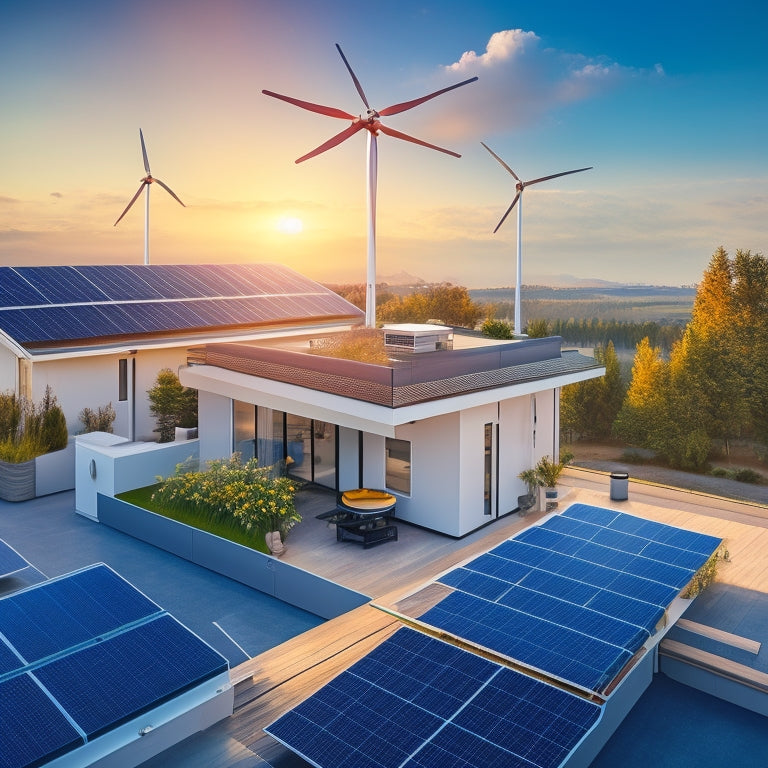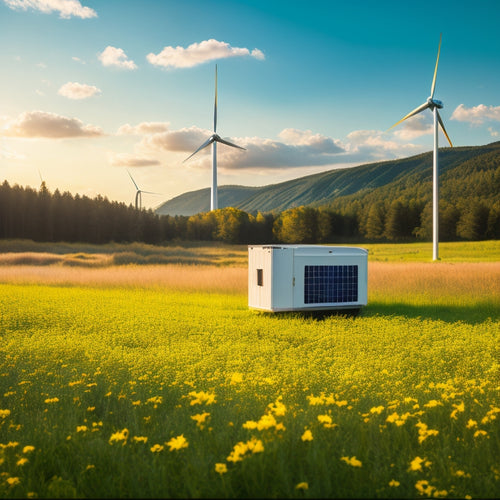
7 Best DIY Energy System Design Tips
Share
When designing your DIY energy system, you'll need to assess your energy needs by analyzing past utility bills and identifying opportunities to reduce energy consumption. Choose the right solar panels by considering efficiency, cost, and local code compatibility. Select a compatible inverter with a high efficiency rating and verify it matches your system voltage. Calculate your battery backup size based on appliance power requirements and energy usage patterns. Design a safe electrical system by establishing electrical safety protocols, conducting risk assessments, and guaranteeing compliance with local codes. By considering these factors, you'll be well on your way to creating a reliable and efficient energy solution that meets your specific requirements, and understanding the subtleties of each component will be key to achieving peak performance.
Overview
- Conduct an energy needs assessment to determine your average daily energy consumption and identify opportunities for reduction.
- Choose the right solar panel type (monocrystalline, polycrystalline, or thin-film) based on efficiency, cost, and local code compatibility.
- Select an inverter with a high efficiency rating (>95%) that matches your system voltage and solar panel voltage range.
- Perform a load calculation to determine your total power requirements and choose the right battery backup and energy storage solution.
- Ensure electrical safety by following established electrical codes and standards, and implementing proper grounding and circuit protection techniques.
Assess Your Energy Needs
Typically, a single-family home consumes around 900-1,200 kilowatt-hours (kWh) of electricity per month.
To design an effective DIY energy system, you need to assess your energy needs accurately. Conduct an energy consumption analysis to determine your home's average daily energy usage. This will help you identify areas where you can implement energy efficiency strategies.
Review your past utility bills to calculate your average energy consumption. Consider factors like appliance efficiency, lighting usage, and heating/cooling systems. By understanding your energy needs, you can design a system that meets your requirements, reducing your reliance on the grid and increasing your energy independence.
Additionally, evaluating your energy usage patterns can help you optimize energy distribution and identify opportunities to reduce your energy bills through strategic storage and usage.
Choose the Right Solar Panels
Your DIY energy system's success hinges on selecting the right solar panels to meet your energy needs.
You'll want to take into account the different panel types, such as monocrystalline, polycrystalline, and thin-film, each with its own efficiency and cost benefits. Monocrystalline panels offer high efficiency but come at a higher cost, while polycrystalline panels provide a balance between efficiency and affordability. Thin-film panels are the most budget-friendly option but have lower efficiency.
Additionally, it's crucial to verify compatibility with local codes and take into account the structural soundness of your roof before installation.
When it comes to installation, verify you follow proper installation tips, such as angling the panels at an ideal 30-40 degrees to maximize energy production and facing them south to capture the most sunlight.
Select a Compatible Inverter
You'll need an inverter that matches your system's voltage and has a high efficiency rating to minimize energy losses.
Look for an inverter with a high peak efficiency rating, usually above 95%, to guarantee maximum energy harvest.
Consider inverter efficiency ratings, such as CEC ratings, for ideal energy conversion.
Verify the inverter's DC input requirements align with your solar panel voltage range to avoid undersizing or oversizing issues.
When selecting an inverter, make certain it's compatible with your solar panel array's voltage and current output to avoid undersizing or oversizing issues.
Inverter Efficiency Rating
Selecting the right inverter for your DIY energy system is essential, and one key consideration is the inverter efficiency rating. You want an inverter that can convert DC power from your renewable energy source to AC power for your home efficiently.
Look for inverters with high efficiency ratings, typically above 95%. There are different inverter types, such as string inverters, microinverters, and power optimizers, each with their own efficiency standards.
Check the California Energy Commission (CEC) efficiency rating, which is a widely recognized standard. A high-efficiency inverter will reduce energy losses and increase your system's overall performance.
Matching System Voltage
The system's voltage is a critical factor in choosing a compatible inverter, as it directly affects the inverter's performance and overall system efficiency. You need to verify the inverter's voltage rating matches your system's voltage to achieve peak energy production.
| System Voltage | Inverter Voltage Rating | Compatibility |
|---|---|---|
| 12V | 12V | Ideal |
| 24V | 12V | Not Compatible |
| 48V | 48V | Ideal |
| 12V | 24V | Not Compatible |
When selecting an inverter, consider voltage compatibility to guarantee seamless system integration. A mismatch in voltage can lead to reduced performance, energy losses, or even system failure. By choosing an inverter that matches your system's voltage, you'll enjoy efficient energy production and a reliable DIY energy system that gives you the freedom you desire.
Calculate Battery Backup Size
Taking into account your energy requirements and the capacity of your renewable energy source, calculating the battery backup size is an essential step in designing an efficient DIY energy system.
To do this, you'll need to perform a load calculation, which involves identifying the total power requirements of your appliances and devices.
Next, you'll need to evaluate the battery chemistry and its associated depth of discharge (DOD) to determine the required battery capacity. A higher DOD means you can use more of the battery's capacity, but it may reduce its lifespan.
Design a Safe Electrical System
When designing a DIY energy system, you'll need to prioritize electrical safety to avoid risks and comply with regulations.
To guarantee a safe electrical system, you'll want to establish electrical safety protocols, conduct a thorough risk assessment using a checklist, and verify compliance with relevant regulations.
Electrical Safety Protocols
Your electrical system's safety begins with a well-designed structure that mitigates risks of electrical shock, fire, and equipment damage.
You'll want to guarantee you're using proper grounding techniques, such as grounding rods and busbars, to direct fault currents safely to earth.
Additionally, implement circuit protection devices like fuses, circuit breakers, and surge protectors to prevent overcurrents and voltage spikes. These measures will help prevent electrical fires and equipment damage.
As you design your system, prioritize safety by following established electrical codes and standards, such as the National Electric Code (NEC).
Risk Assessment Checklist
To guarantee your DIY energy system is designed with safety in mind, you must identify potential risks and hazards. Start by creating a risk assessment checklist to evaluate your system's components and potential failure points.
Identify risk factors such as electrical shock, fire, and equipment damage. Then, develop mitigation strategies to minimize or eliminate these risks. Consider factors like component quality, installation methods, and maintenance requirements.
For each risk, assign a likelihood and impact score to prioritize your mitigation efforts. By systematically evaluating and addressing potential risks, you can design a safe and reliable DIY energy system that meets your needs and guarantees your freedom from energy dependence.
Compliance With Regulations
Building a DIY energy system requires compliance with local electrical codes and regulations to guarantee a safe and reliable electrical system. You'll need to research and understand the specific regulations in your area, as they can vary greatly.
| Regulation | Requirement |
|---|---|
| Electrical Code | Meets local electrical code standards (e.g., NEC) |
| Permitting | Obtain necessary permits before starting installation |
| Inspection | Schedule inspections with local authorities |
You'll need to maneuver through the permitting process, which may involve submitting plans and undergoing inspections. Don't skip this step, as non-compliance can result in fines, safety hazards, or even system shutdown. By following local regulations, you'll guarantee a safe and compliant DIY energy system that meets your needs and provides the freedom you desire.
Plan for Energy Storage Capacity
Designing a DIY energy system requires careful evaluation of energy storage capacity to guarantee a reliable and efficient power supply.
You'll need to determine your energy storage needs based on your energy usage patterns, location, and system design. When selecting energy storage technologies, take into account factors such as depth of discharge, round-trip efficiency, and lifespan.
Battery chemistry options like lithium-ion, lead-acid, and nickel-cadmium each have their pros and cons. You'll also need to take into account the type of charging and discharging cycles your system will require.
Ensure a Grid-Ready Connection
With your energy storage capacity planned, you're now ready to focus on guaranteeing a grid-ready connection. This involves traversing the grid interconnection process, which can be complex and time-consuming.
To avoid delays, research your utility's specific requirements and guidelines for connecting to the grid. Develop utility partnership strategies to facilitate a smooth interconnection process.
Confirm your system design meets the necessary safety and technical standards. You'll need to provide detailed documentation, including system schematics and performance data.
Frequently Asked Questions
Can I Install a DIY Energy System in a Rented Property?
You can install a DIY energy system in a rented property, but you'll need to take into account temporary installations and obtain landlord permissions to guarantee a hassle-free setup that doesn't compromise your lease agreement.
How Do I Handle Energy System Maintenance and Repairs?
You'll guarantee your DIY energy system runs smoothly by implementing preventive measures like regular inspections and cleaning, and knowing basic troubleshooting techniques to identify and fix common issues before they escalate into costly repairs.
Are DIY Energy Systems Compatible With All Electrical Appliances?
Can you really call yourself off-grid if your DIY energy system can't power your favorite appliances? Luckily, most systems are compatible, but it's essential to guarantee system efficiency by choosing appliances that match your system's voltage, frequency, and power output.
Do I Need to Notify My Utility Company About My DIY System?
When installing a DIY energy system, you'll need to notify your utility company to guarantee compliance with safety regulations and a safe grid connection, allowing you to maintain autonomy while avoiding potential hazards and fines.
Can I Sell Excess Energy Back to the Grid With a DIY System?
You're sitting on a goldmine of excess energy! With net metering benefits, you can sell it back to the grid and rake in the credits. Consider energy storage options to maximize your returns and break free from the grid's shackles!
Ready to Buy
You've made it! With these 7 DIY energy system design tips, you're well on your way to utilizing renewable energy and reducing your reliance on the grid. Did you know that the global solar market is projected to reach 1.3 terawatts by 2023, a staggering 300% increase from 2019? By designing your own energy system, you're contributing to this sustainable energy revolution. Now, go ahead and get creative with your DIY project, and enjoy the benefits of clean energy and reduced energy bills!
Related Posts
-

What Types of Solar Energy Devices Are Available
You'll find several types of solar energy devices available today, each customized to different energy needs. Photovo...
-

Sustainable and Eco-Friendly Generators for a Reduced Carbon Footprint
Sustainable and eco-friendly generators are perfect for cutting your carbon footprint and increasing energy efficienc...
-

Designing a Green Roof for Maximum Energy Efficiency
Designing a green roof for maximum energy efficiency involves several key strategies. Start by selecting native, drou...


